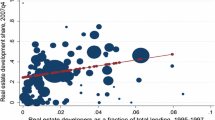Abstract
This paper uses time-series analysis to model explicitly the take-up rate of the UK Government's Loan Guarantee Scheme over the 1980s. In doing so we consider the rationale for the scheme in the context of empirical and theoretical research into the financing of small businesses and in particular the nature of the small firm/bank relationship. To begin we discuss the history and evolution of the scheme from its inception in 1981. A theoretical model is then outlined in which LGS funds are used to maximise the utility of capital constrained entrepreneurs.
Using this framework we find that the UK Government can do much to influence the levels of both take-ups and failures of firms on the scheme by directly altering the parameters. The scheme's apparent success as a [relatively] cost-effective job generation package suggests more could be done to extend the scheme to aid more start-up firms and those existing firms wishing to expand.
Similar content being viewed by others
References
Besanko, D. and A. Thakor, 1987, ‘Competitive Equilibrium in the Credit Market Under Asymmetric Information’,Journal of Economic Theory 42, 167–182.
Binks, M., C. Ennew and G. Reed, 1988, ‘Banks and Small Business: An Interbank Comparison’,Report to Forum for Private Business, Knutsford, Cheshire.
Birch, D. L., 1979, ‘The Job Generation Process’, MIT Program on Neighbourhood and Regional Change, Cambridge, Massachusetts: MIT, Mimeo.
Black, J., D. de Meza and D. Jeffreys, 1992, ‘House Prices, the Supply of Collateral and the Enterprise Economy’,Mimeo, Department of Economics, University of Exeter.
Bogenhold, D. and U. Staber, 1991, ‘The Decline and Rise of Self-Employment’,Work, Employment and Society 5, 1–2.
Cambridge Small Business Research Centre, 1992, ‘The State of British Enterprise’, University of Cambridge.
Clay, N. and S. Creigh-Tyte, 1994, ‘The Role of the Small Firm in European Industrial Economics’,Review d'Economie Industrielle, Special Issue, 76–79.
Cowling, M., P. Mitchell and S. Creigh, 1993, ‘Trends in Self-Employment: Government Policy and the Role of the Macroeconomy’, inSmall Businesses in International Markets 1, 23rd European Foundation for Management Development, Belfast, 129–140.
Cowling, M., J. Samuels and R. Sugden, 1991, ‘Small Firms and Clearing Banks: A Sterile, Uncommunicative and Unimaginative Relationship’,Association of British Chambers of Commerce, London.
Cressy, R. C., 1993, ‘Loan Commitments and Business Starts: An Empirical Investigation on UK Data’,Small Business Economics, forthcoming.
Cuthbertson, K. and J. Hudson, 1990, ‘The Determination of Compulsory Liquidations in the UK: 1972–1988’,Journal of International Economics 18, 79–91.
Daly, M., M. Campbell, G. Robson and C. Gallagher, 1991, ‘Job Creation 1987–89: The Contributions of Small and large Firms’,Employment Gazette, November, 589–596.
Evans, D. and L. Leighton, 1989, ‘Some Empirical Aspects of Entrepreneurship’,American Economic Review 79, 519–535.
Hutchinson, R. W. and D.G. McKillop, 1992, ‘Banks and Small to Medium Sized Business Financing in the United Kingdom’,National Westminster Bank Quarterly Review 1, 85–94.
Keasey, K. and R. Watson, 1992, ‘Investment and Financing Decisions in the Performance of Small Firms’,National Westminster Bank, London, 15–16.
National Audit Office, 1988, ‘Department of Employment/Training Commission: Assistance to Small Firms’, Report by the Comptroller and Auditor General, No. 655, London: HMSO.
National Economic Research Associates, 1990, ‘An Evaluation of the Loan Guarantee Scheme’,Department of Employment, Research Paper No. 74.
Robson, M., 1991, ‘A Survey of Recent Time-Studies of Business Formations and Dissolutions in the United Kingdom’,Mimeo, University of Newcastle.
Robson, M., 1992, ‘Macroeconomic Factors in the Birth and Death of UK Firms: Evidence from Quarterly VAT Registrations’, Newcastle Discussion Papers in Economics.
Sharpe, S., 1990, ‘Asymmetric Information, Bank Lending and Implicit Contracts A Stylised model of customer relationships’,Journal of Finance 65(4), 1069–1087.
Storey, D. and S. Johnson, 1987, ‘Are Small Firms the Answer to Unemployment?’, London: Employment Institute.
Wilson Committee, 1979, ‘The Financing of Small Firms, Interim Report of the Committee to Review the Functioning of the Financial Institutions’, Cmnd 7503, London: HMSO.
Author information
Authors and Affiliations
Rights and permissions
About this article
Cite this article
Cowling, M., Clay, N. Factors influencing take-up rates on the Loan Guarantee Scheme. Small Bus Econ 7, 141–152 (1995). https://doi.org/10.1007/BF01108687
Accepted:
Issue Date:
DOI: https://doi.org/10.1007/BF01108687




